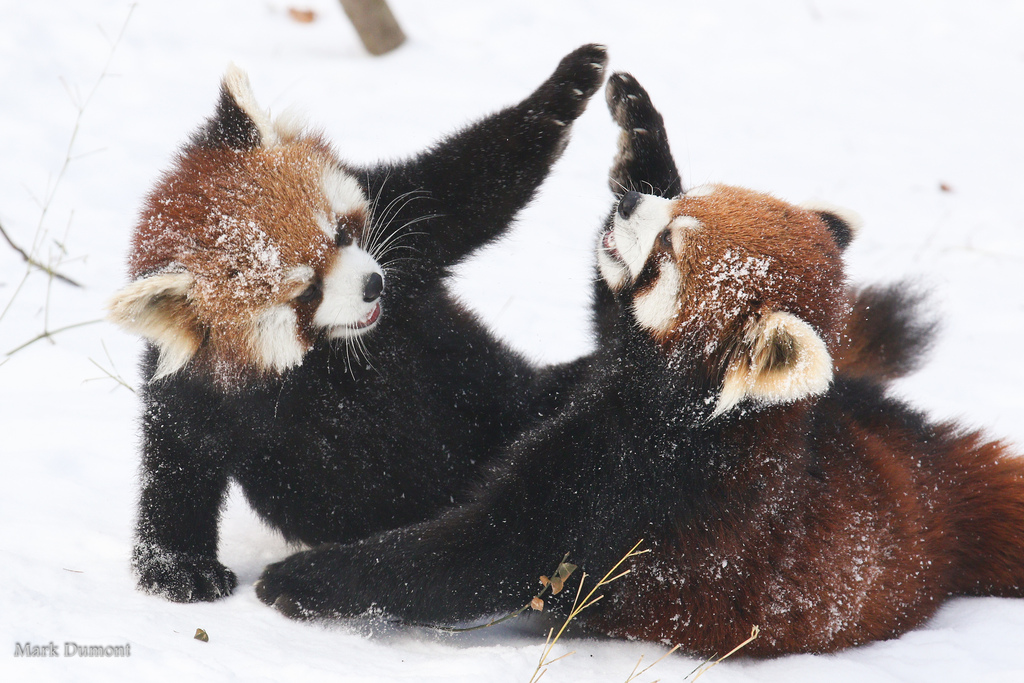Winter is Here and So Are These Cold-Weather Loving Animals
The Cincinnati Zoo & Botanical Garden is open for 364 days of fun! It’s also home to more than 500 animal species, many of which actually enjoy this winter weather! While certain animals like Fiona (who can only be outside if it’s 45 degrees or warmer) and most primates stay inside on the colder days of winter, there are plenty of animals that were built for the cold. And unlike humans, these cold-weather animals have unique adaptations to keep them extra warm on chilly winter days!
 Reindeer
Reindeer
- Reindeer warm the air they breathe in through their nostrils as well as adding moisture to the otherwise dry winter air as they exhale!
- They are the only mammal that can see ultraviolet light. Their eyes change color from golden in the summer to dark in the winter. Both these adaptations allow them to see better with more clarity in the snowy regions.
- Their hooves also go from a spongy softness in the summer months to more of a hardened hoof in the winter months to help them navigate in the snow.
- Reindeer are the only deer species where both sexes have antlers. Males generally lose their antlers after the breeding season (mid -November to early December) while females maintain theirs until the spring. Females will use the antlers like snow shovels to help clear snow to find the grass, lichens and mosses that they feed on while they are going through their 7 month gestation period.
- They have hollow outer hairs that help insulate their bodies as well as make them more buoyant as they cross rivers and deep streams during their long migrations.
- Reindeer mothers produce milk that has one of the highest fat contents of any mammal species.
 Red Panda
Red Panda
- Red pandas are covered entirely in fur except for their nose and eyes to help stay warm and not slip on icy branches.
 Snow Leopard
Snow Leopard
- The snow leopard’s five-inch thick coat affords great protection from the cold.
- The coat also comes in handy as camouflage, helping the leopard blend in with the rocky terrain to hide from potential prey. Sadly, the beautiful coat also hinders the leopard’s survival, as poaching for the fur is one of its major threats.
- They also use their thickly furred tail like a muffler or scarf to help protect their face from the wind while lying down
 Polar Bear (from Polar Bears International)
Polar Bear (from Polar Bears International)
- To keep them warm, polar bears have black skin over a thick layer of fat that can measure up to 4.49 inches.
- In the water, they rely more on their fat layer to keep warm; wet fur is a poor insulator.
- Their skin isn’t the only thing working to keep them warm—their ears are small and round, and their tails short and compact, to conserve the most heat possible.
- Polar bear paws are ideal for roaming the Arctic. They measure up to 11.81 inches across, to help polar bears tread on thin ice. When the ice is very thin, the bears extend their legs far apart and lower their bodies to distribute their weight.
- Black footpads on the bottom of each paw are covered by small, soft bumps known as papillae. Papillae grip the ice and keep the bear from slipping.
- Polar bears also have hollow outer hairs that further help to insulate them from the cold and helps this marine mammal to remain buoyant while as it often needs to swim great distances.
 Arctic Fox
Arctic Fox
- The Arctic fox trades in its dense, white winter fur for a lighter, brown coat in summer.
 King Penguin
King Penguin
- King penguins have a thick layer of body fat and a waterproof coat that insulates from icy temperatures.
- Penguins are counter-shaded for camouflage; while swimming, the black back blends in with the dark sea below, and the white belly blends in with the sunlight above.
- On land, tobogganing on their bellies is a quicker way to get around than walking.
 North American River Otter
North American River Otter
- River otters’ special two-layered fur coat allows them to keep warm.
- A river otter has 450,000 hairs per square inch which sounds like a lot but a sea otter has the densest fur of any animal with 1 million hairs per square inch!
 California Sea Lion
California Sea Lion
- Sea lions have thick layers of blubber to insulate their bodies from the cold. Duke gets around 20 pounds of fish per day in the winter to help him stay warm!
 Local Insects
Local Insects
- A lot of insects that live in temperate areas like Ohio will deal with winter by laying their eggs before it gets cold, and then only their eggs survive the winter. They will hatch the following spring and the young will grow up and lay more eggs before the next winter. Some local insects will overwinter as adults – like the ladybug which will take shelter under fallen leaves to stay warm. American Burying Beetles will burrow underground and overwinter as adults, only emerging to eat when it’s warm enough.
Be sure to check out these cool creatures on your next winter zoo visit. There are plenty of indoor viewing areas as well, so those of us without adaptations for the cold can warm up! These include Dragons!, Manatee Springs, Wings of Wonder Bird House, the Reptile House or World of the Insect & more! Stay warm!

